Cannoli are among the most iconic Italian desserts. They’re a beautiful and delicious treat made from shells of perfectly crisp, golden pastry filled with creamy, dreamy cinnamon and chocolate-flecked ricotta. I’ll teach you how to make cannoli shells and cannoli filling at home!
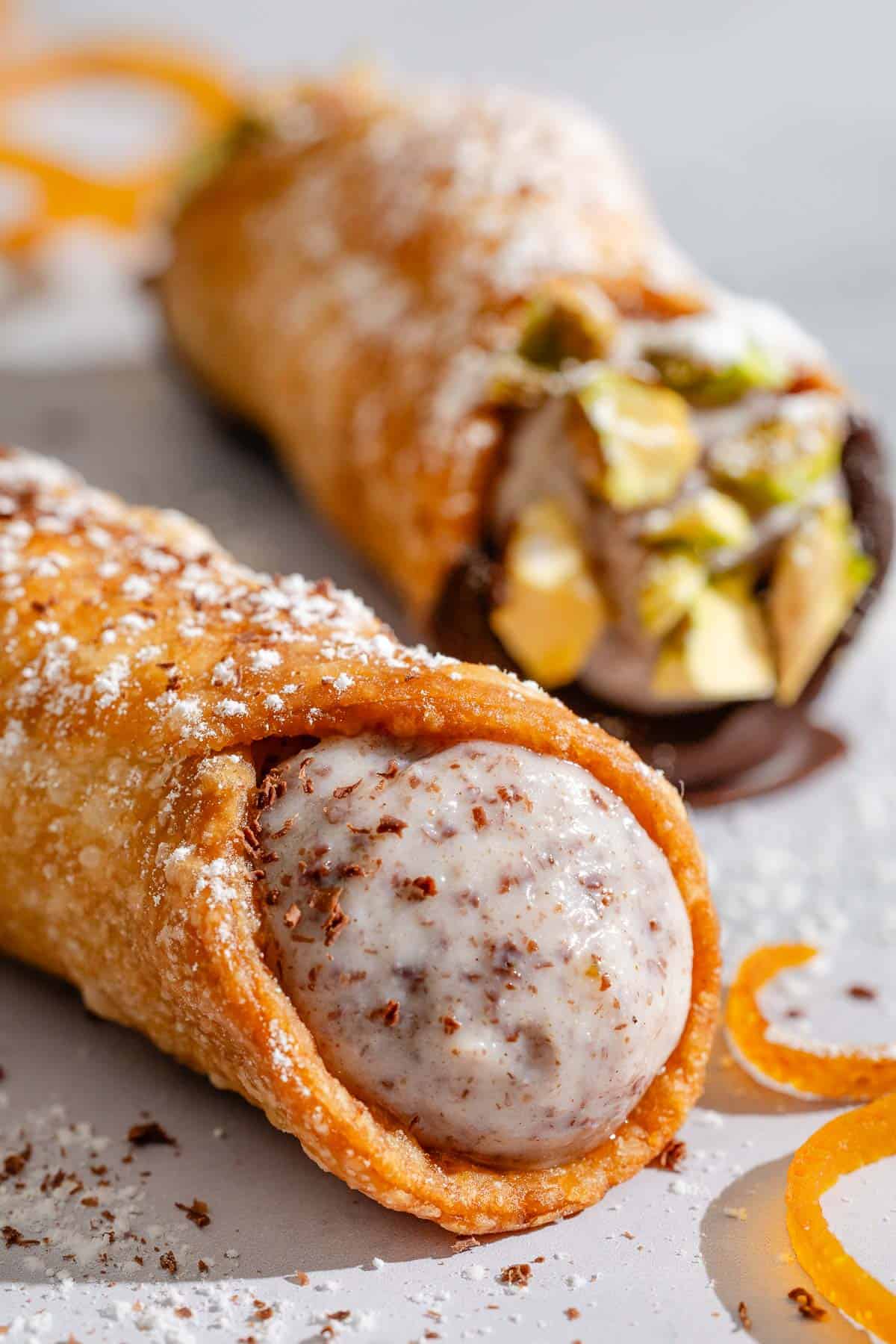
Cannoli are an impressive dessert to serve at dinner parties with cups of hot coffee. Even if you don’t have an Italian bakery near you, you can make these Italian treats in your own kitchen, and yes—even the shells are homemade!
My cannoli recipe is a labor of love; it requires some hands-on time and some special equipment, but the results are so delicious that I think it’s worth it to treat yourself (and your loved ones) once in a while. Oh, and if you’re looking for something with the same flavor profile but no special equipment necessary, try our Easy Cassata Cake (Italian Sponge Cake With Ricotta, Chocolate, And Honey).
Whether you’re an expert or trying cannoli for the first time, this recipe is a fun, delicious way to bring a little taste of Sicily to your table. Read on and learn how to make cannoli at home as amazing as the ones you’ll find in a Palermo pastry shop.
Table of Contents
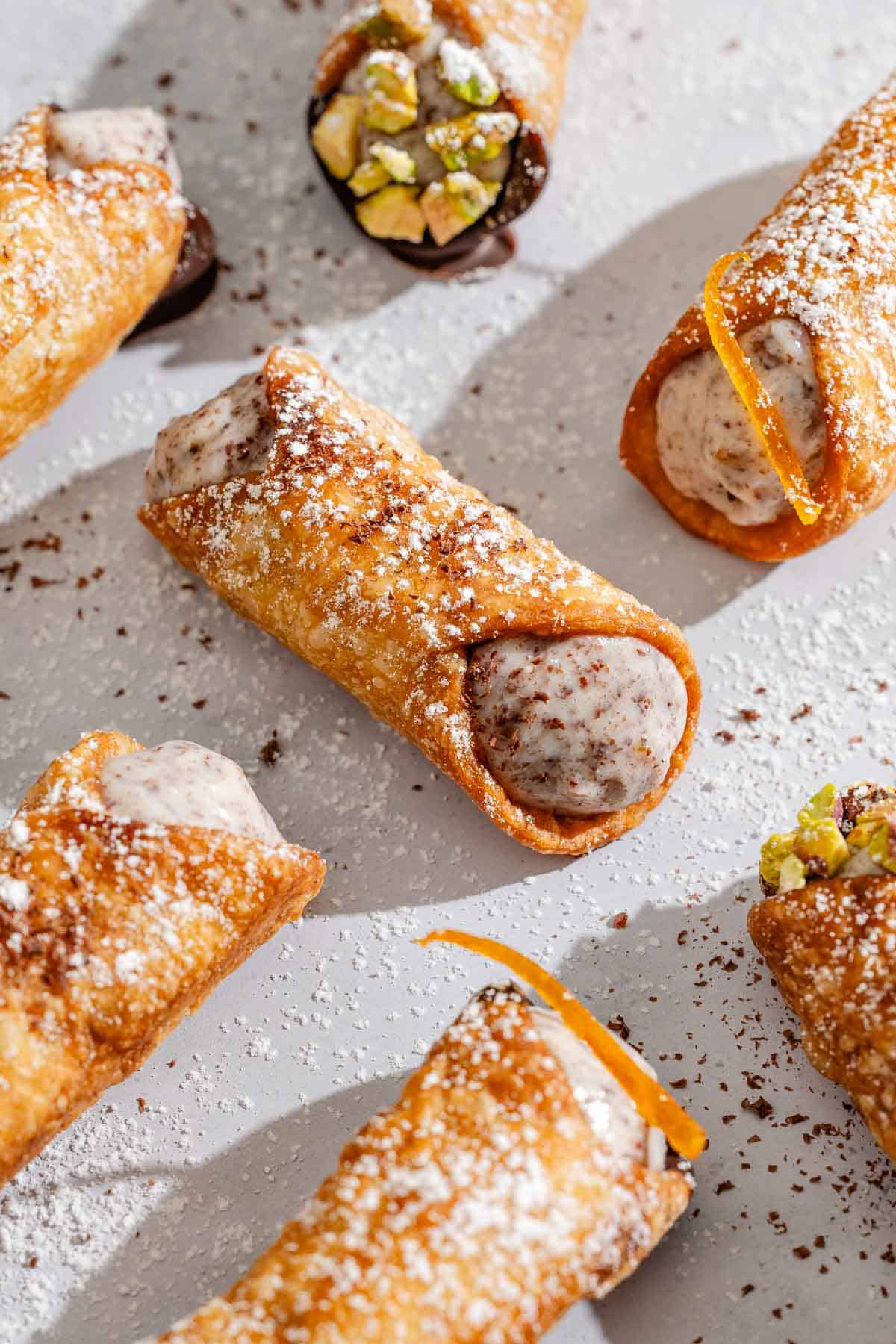
What is a Cannoli?
Cannoli (singular cannolo) literally translates from Italian to “little tubes,” referring to the shape of the crispy pastry shells.
The famous treats are originally from Sicily, in the south of Italy. There, you’ll find them flavored with candied orange peel, dark chocolate, candied cherries, or pistachios.
They are made of two main components. First, the pastry shells, which are made from a marsala wine dough and historically fried in lard. Then, a creamy filling made from fluffy ricotta cheese. Finally, a little decoration! Sometimes the shells are dipped in chocolate or the filling has extras folded in. Often the decoration is as simple as a sprinkle of powdered sugar or chopped nuts.
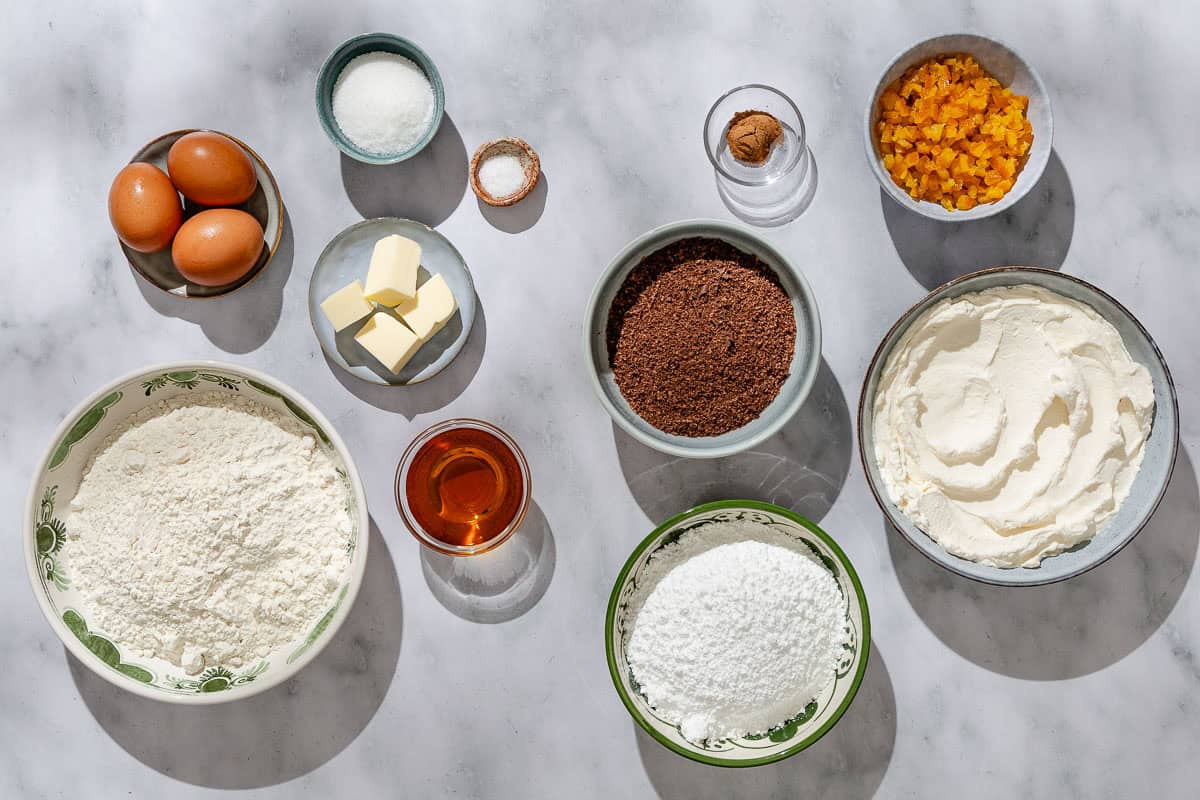
Ingredients for Cannoli
Cannoli have two main components, the shells and the filling, plus whatever finishing touches you choose. Here’s everything you’ll need:
Cannoli Shells
While not difficult to make, the dough for cannoli shells is sort of cross between a pasta and a pastry. Here’s what goes into it:
- All-purpose flour: Flour forms the base of the pastry dough and helps prevent the dough from sticking to your work surface as you roll it out.
- Salt: A pinch of salt enhances the other flavors in the dough.
- Sugar: A few tablespoons of granulated sugar adds a hint of sweetness and ensures that the cannoli shells fry up a beautiful golden brown color.
- Butter: Butter adds rich flavor and a flaky texture to the cannoli dough. I recommend using unsalted butter; salted butter can make the dough taste too salty.
- Eggs: Beaten eggs give the dough a golden color and help bind it together.
- Marsala wine: Wine might seem like an unlikely ingredient for a dough, but it adds some sweetness, helps to tenderize the pastry, and evaporates as the shells fry, giving them the pastry shells their signature bubbly texture.
- Egg white and water mixed together make an egg wash, which helps seal the cannoli shells closed so they hold their tube shape while frying.
- Oil: Deep frying gives cannoli shells their irresistibly crunchy texture. You can use extra virgin olive oil for frying, but vegetable or canola oil are more cost-effective options. Use a thermometer to check the temperature of your oil!

Cannoli filling
My favorite cannoli filling has a little chocolate, cinnamon, and citrus in a creamy base.
- Ricotta cheese: Whole milk ricotta cheese, drained of some of its liquid, gives cannoli filling its signature flavor. Don’t substitute low-fat or fat-free ricotta in this recipe, they’ll result in a texture that feels sandy instead of smooth.
- Chocolate: Finely grated chocolate flavors the filling, and we dust some on top, too. Dark chocolate is my preference here because it keeps the filling from becoming too sweet, but you can use milk chocolate. You can also swap in mini chocolate chips.
- Confectioners’ sugar sweetens the cannoli filling, combining completely with the cheese for a smooth texture.
- Cinnamon adds a warm, sweet-spicy kick.
- Candied fruit: I like to chop up some candied orange peel to add a hint of citrus to the filling. It’s optional, but you can find this ingredient at most large local grocery stores or make your own!
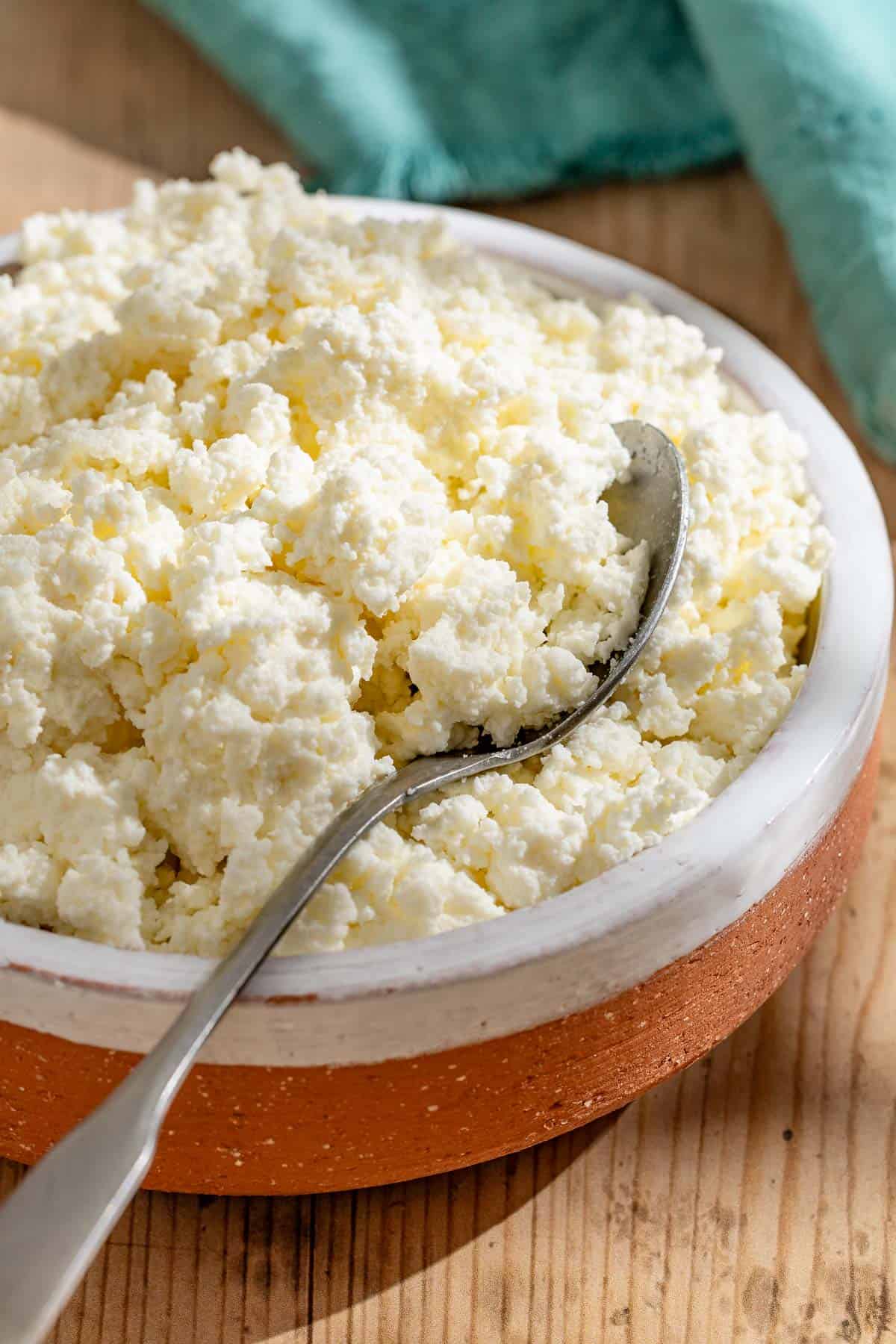
Ingredient Spotlight
Ricotta cheese, an essential element of cannoli filling, is one of my favorite baking ingredients. If you love dessert, but don’t want too much sweetness, ricotta makes an indulgent cheesecake, a tender lemon cake, a moist and beautiful orange cake, and a rich but light chocolate citrus cassata cake.
American ricotta brands, often sold in tubs at the supermarket, are made using cow’s milk. Italian ricotta brands, which are often sold in little mesh baskets, are often made using sheep’s milk or a combination of milks that might include cow, goat, sheep, and even water buffalo milk.
For the best flavor and texture, I recommend using whole milk ricotta for this recipe. Taking the time to drain it in the fridge overnight will ensure that your cannoli filling is creamy, not wet.
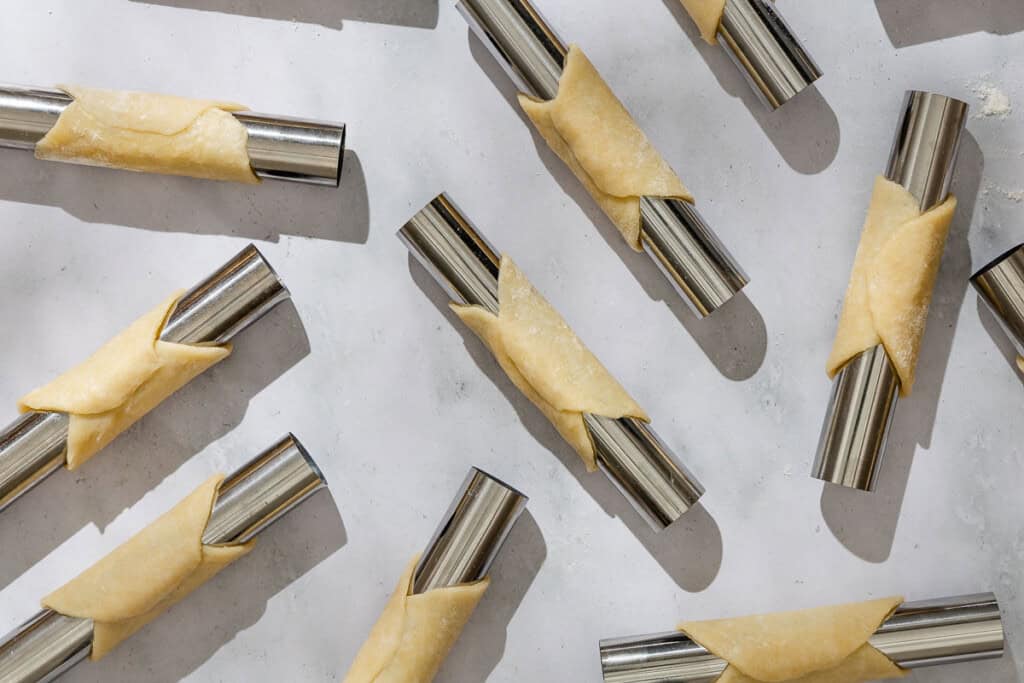
Tools for Cannoli
You need one tool that is specific to the task of making cannoli, and a few other pastry-rolling essentials. Here’s what you’ll want to have on hand:
- Cheesecloth or paper towels: It’s important to drain away excess liquid from the ricotta. A doubled-up layer of cheesecloth, a few layers of sturdy paper towels, or a flour sack-style cotton or muslin dish towel will all work.
- Rolling pin: The most critical step of getting cannoli with a crisp, snappy texture is to roll the dough out very thinly so the moisture evaporates quickly and evenly as they fry. Use wide rolling pin or a pasta roller to accomplish this!
- Cannoli molds: Cannoli forms look like short segments of stainless steel tubing. They work by wrapping the dough around them and then frying the whole thing. They’re often sold in sets of four, but I think it’s better to work with 6 to 8 at a time, otherwise the forming and frying process takes longer!
- 3-inch cutter: You can also use a drinking glass, but a cutter with a sharp edge makes it easier to cut the pastry neatly.
- Piping bag: A piping or pastry bag is the best way to add the cannoli filling to the pastry when you’re ready to serve the cannoli. I think it’s easiest to use a large bag so you don’t have to refill it.
- Thermometer: It’s helpful to have either an instant-read thermometer or a deep frying thermometer for making this recipe to ensure that your oil is at the right temperature for frying. Too hot and the cannoli shells may darken too quickly and develop bitter flavor notes. Too cold and the shells will be pale and soggy.
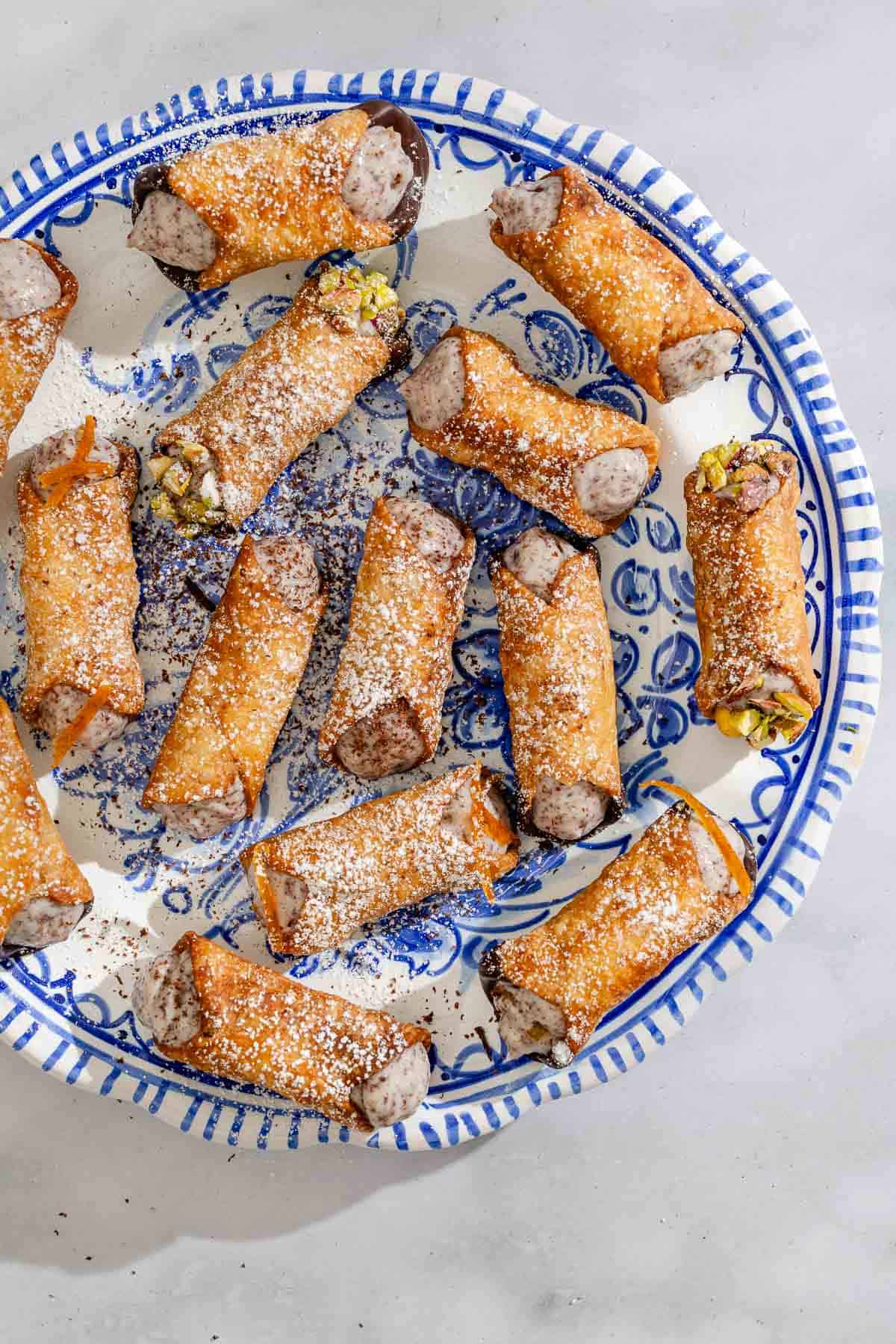
How to Make Cannoli
I love serving cannoli on special occasions, especially if I have a small crowd. Cannoli are elegant and beautiful, and make an eye-catching dessert that pairs well with a strong cup of coffee. Here’s how to do it:
A Day Ahead: Drain the Cheese
- Strain the ricotta cheese. Place a fine mesh sieve over a bowl. Line the sieve with 2 layers of cheesecloth, or a flour sack towel. Add 12 ounces of whole milk ricotta cheese and use the back of a spoon to smooth it into an even thickness. Allow the ricotta to drain overnight in the refrigerator.
To Make Cannoli Shells
- Prepare the pastry: Sift 2 cups (256 grams) all-purpose flour, a pinch of salt, and 3 tablespoons sugar into a large mixing bowl. Using your fingertips, rub in 4 tablespoons of unsalted butter until you have a coarse mixture. Mix in 2 beaten eggs and 3 tablespoons Marsala wine. Turn the dough onto a lightly floured work surface and knead by hand until you have a smooth dough. (If the dough is too sticky, add a little bit of flour at a time and continue to knead until you are able to form a smooth ball.) Place the dough back into the bowl and refrigerate it for an hour.
- Roll out and cut the dough. Take the pastry dough out of the fridge. On a clean, thoroughly floured work surface, roll the pastry dough out as thinly as possible (1/16-inch). Lift and flip the dough occasionally, adding more flour as necessary to roll it out, to ensure it’s not sticking to the surface. If the dough begins to resist rolling and shrink back, transfer it to a baking sheet and refrigerate for 15 minutes, then continue rolling. Using a 3-inch round cookie cutter or a drinking glass, cut the dough into rounds. You should have between 18 and 24 rounds.
- Form the cannoli shells. Mix 1 lightly beaten egg white with 1 tablespoon of water to make an egg wash. Dust cannoli molds with flour and wrap each pastry circle around a cannoli mold. Dampen the edge of the dough with the egg wash and press to seal the two edges of the circle shut where they meet in the middle. After shaping, return the formed shells on their molds to the fridge until you’re ready to fry them.
- Fry the cannoli shells. Fill a saucepan a third of the way with oil. Heat the oil to 350°F. Line a plate with a paper towel. A few at a time, deep fry the cannoli shells until they are uniformly golden and crisp, just a few moments. Using tongs or a large slotted spoon, transfer the molds to the prepared plate. When the molds and pastry shells are cool enough to handle, gently twist the cannoli forms to release the shells. Repeat the process of forming and frying the cannoli shells until all the shells are fried and set them aside to cool completely. Once cooled, store the shells in an airtight container until ready to serve.
To Make Cannoli Filling
- Mix the filling: In a mixing bowl, combine the strained ricotta, 2 ounces of finely grated dark chocolate, 3/4 cup confectioners’ sugar, 1/2 teaspoon ground cinnamon, and, if using, 3 ounces of finely chopped candied fruit. Mix until all is well combined and transfer to a piping bag, if you like. Refrigerate until ready to serve.
- Fill the cannoli and serve. Just before serving, pipe or spoon the filling into the cannoli shells. Dust them with a generous amount of confectioner’s sugar and more grated dark chocolate.
Cannoli Variations
You can use the base filling recipe customized with any mix-ins you like to change the flavor of the cannoli. There must be endless ways to dress up cannoli by adding different mix-ins or decorations. Here are a few more ideas for how to dress up your cannoli.
- Chocolate-dipped cannoli: After frying the shells and cooling them completely, dip the ends into melted chocolate. Place them onto a baking sheet lined with parchment or wax paper, then refrigerate to set. Once the chocolate hardens, fill the shells.
- Pistachio, hazelnut, or almond cannoli: Finely chop up unsalted pistachios, almonds, or hazelnuts. Once you fill the cannoli shells, dip the ends into the chopped nuts. The nuts will cling to the cheese filling in the cannoli. You can also add a few drops of almond, hazelnut, or pistachio extract to the filling mixture to add another layer of nutty flavor, if you like.
- Cherry cannoli: Skip adding the candied citrus rind and instead press an amarena cherry, a type of candied wild cherry, into the cream at the end of each cannoli. These are also ridiculously good with a few drops of almond extract in the ricotta filling.
- Chocolate cannoli: Add a tablespoon or two of cocoa powder to the flour mixture to make chocolate cannoli shells! Take caution cooking them though; the dark color of the dough can make it difficult to judge how cooked they are while frying!
- Swap in store-bought shells: Without a doubt, the most laborious part of making cannoli is forming the shells. If you’re looking for an easier option, check with your local Italian specialty shop or bakery about buying pre-made shells. You can also order pre-cooked cannoli shells online!
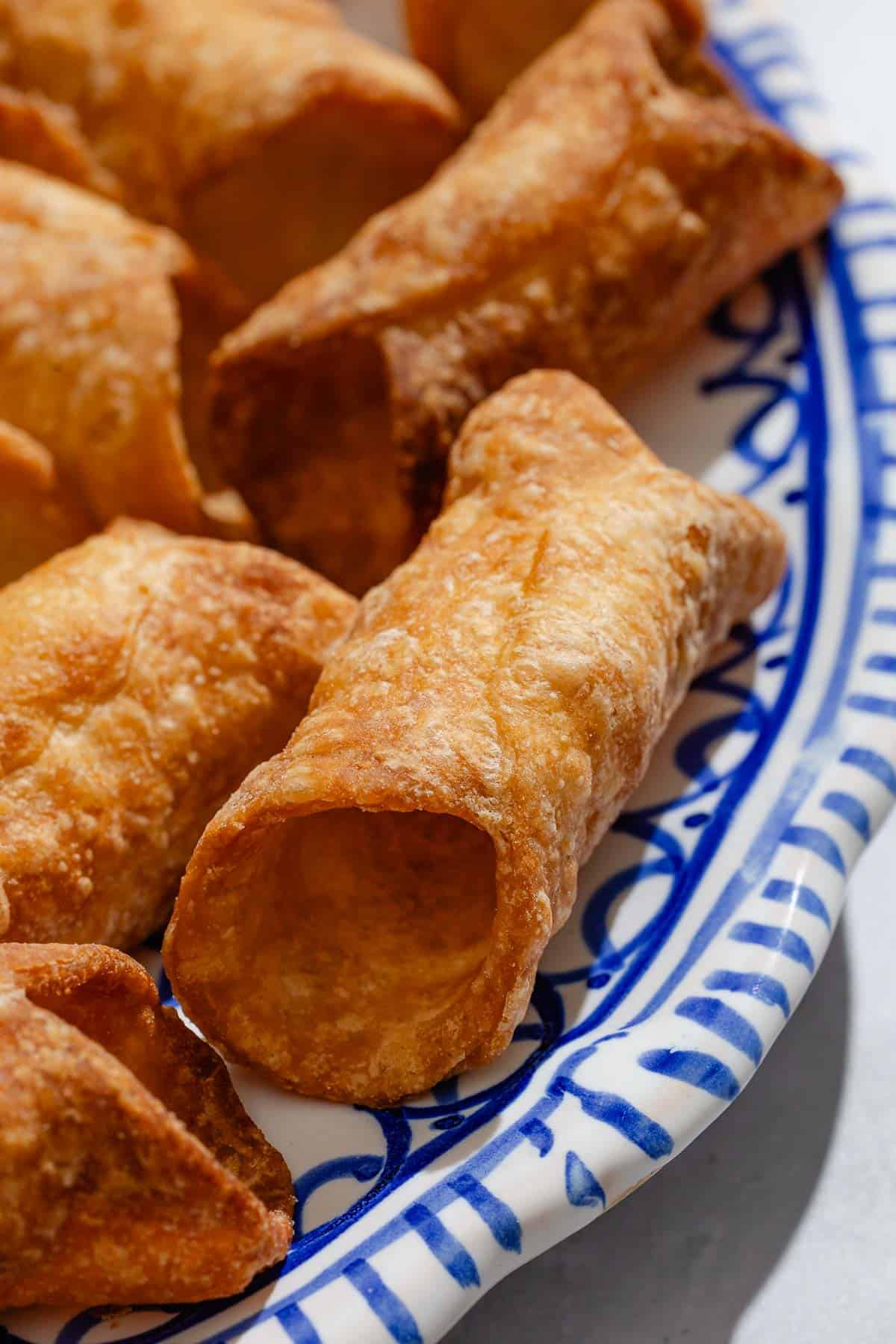
Cannoli Making Tips
Here are a few of my key strategies for success to consider if this will be your first time making cannoli!
- Choose a low-moisture ricotta. The moisture content of ricotta cheese varies widely among brands, and a ricotta with a wet texture will make the filling too thin and impossible to pipe. You can also make your own homemade ricotta allowing you to better control the moisture content.
- Check the texture of your ricotta. If your ricotta feels dry and holds its shape when dolloped on a plate, it will need less draining time. If a spoonful slumps, or liquid pools around it, it will need more.
- Re-strain if your filling is too wet. If, once you mix up your filling, you find that it’s too wet to pipe, line a fine mesh sieve with cheesecloth, a cotton or muslin flour sack towel, and add the entirety of the filling mixture. Return it to the fridge and let it drain for a few more hours until it firms up.
- Chill the dough. The dough is easiest to work with then it’s a little cold. If, at any point in the process, you find your dough is getting unwieldy, place it in the fridge for 15 to 20 minutes to firm it up and relax the gluten, then proceed.
- Use a pasta roller. If you have a pasta machine, use it to help sheet the dough instead of rolling it out by hand! Start at the widest setting and then work progressively thinner.
- Really roll out the dough. I have found that the key to giving cannoli shells that hallmark bubbly texture is rolling the dough for the shells as thin as I can. If the dough is too thick the resulting shells cook unevenly and have an almost stale texture, even when freshly fried.
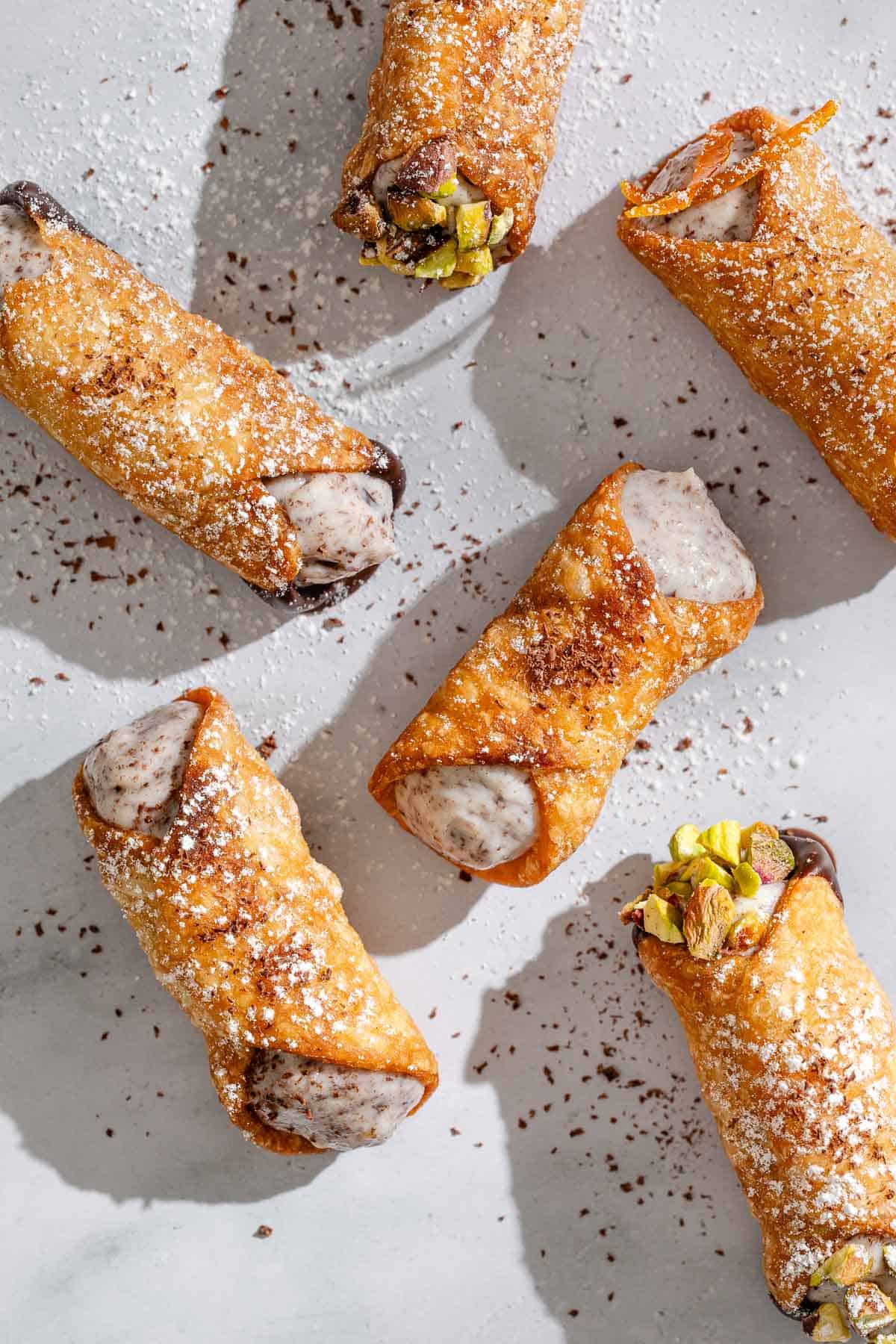
How to Store Cannoli
Store fried, but unfilled cannoli shells in an airtight container at room temperature for about a week. The filling can be stored in an airtight container or piping bag in the refrigerator for up to 5 days.
Once filled, cannoli go soggy very quickly, so it’s best to add the filling right before serving!
How to Freeze Cannoli
You can prep and freeze both cannoli shells and filling to serve at a later date! After the fried shells have cooled, carefully place them in a freezer-safe container.
A hard container is the best option so the shells don’t get crushed. Leave a little space between them or add strips of parchment paper to prevent them from touching so they don’t freeze together. Cannoli shells can be stored frozen for about 2 weeks. Stored longer than that I find that they lose their crispness.
To freeze the cannoli filling. Place it in a freezer-safe bag or container, and freeze for up to a month. If it separates once thawed, drain off any extra liquid, then mix it gently to combine everything again.
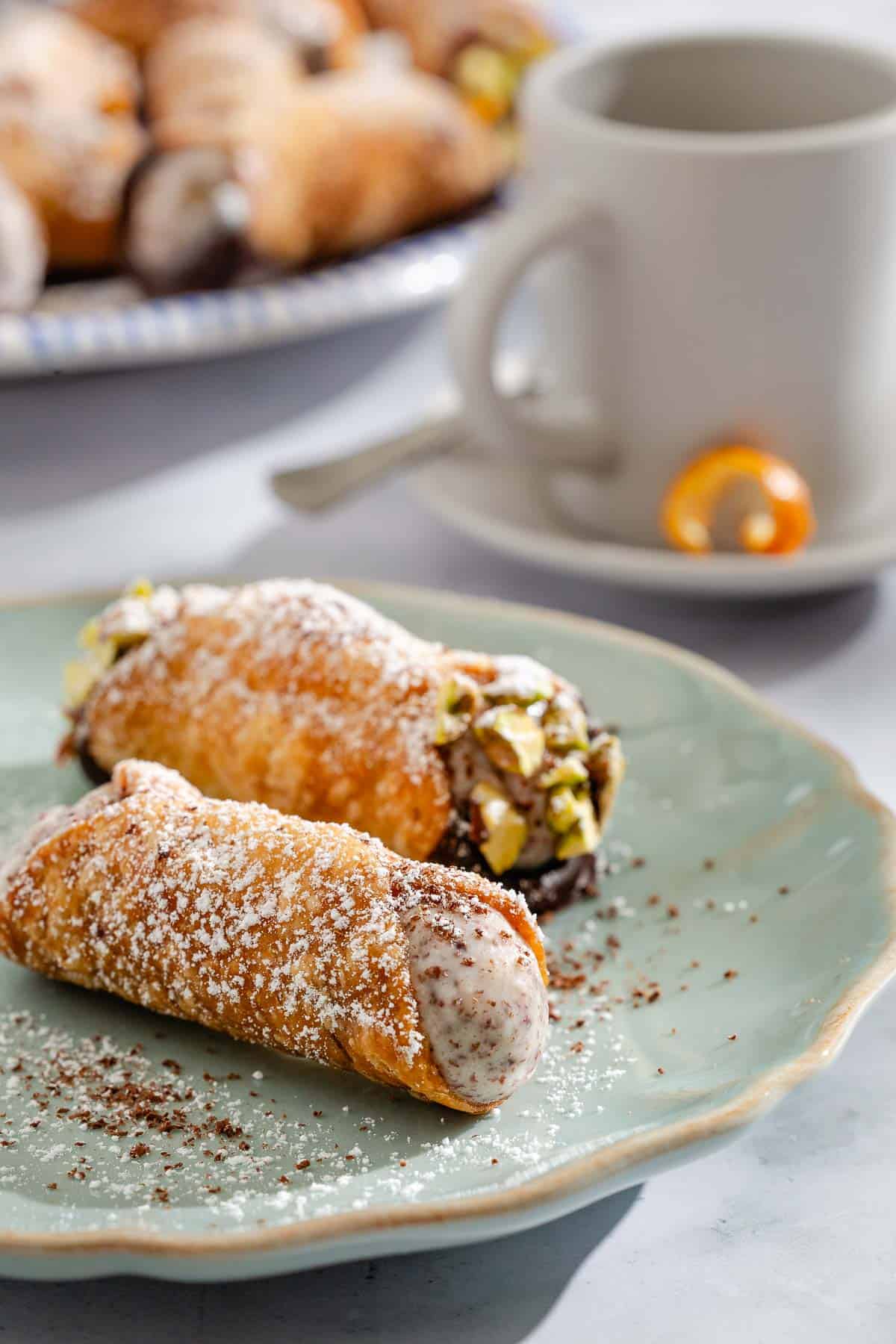
What to Serve with Cannoli
Cannoli are a special event in and of themselves. They’re a wonderful end to any Italian feast, and because they’re so hands-on I think it’s best to serve them when the rest of the menu is pretty simple. What I’m saying is don’t plan to make pasta from scratch and cannoli on the same day!
Enjoy these famous Sicilian treats after a meal of some of Sicily’s other famous dishes: an appetizer of savory, sweet, and tangy Caponata, hearty Pasta alla Norma with tender eggplant and tomato; or oozy, cheese-filled Arancini.
You could also make them the main event and serve them on their own as an impressive afternoon or holiday treat with espresso!
Even More Iconic Italian Sweets
Browse all Mediterranean recipes.
Visit Our Shop.
Cannoli

Equipment
- 3-inch circle cutter
- pastry bag
Ingredients
For the filling
- 12 ounces whole milk ricotta cheese
- 2 ounces dark chocolate, finely grated, plus more for dusting
- 3/4 cup confectioners’ sugar, plus more for dusting
- 1/2 teaspoon ground cinnamon
- 3 ounces candied fruit, finely chopped (optional)
For the pastry
- 2 cups (256 grams) all-purpose flour, plus more as needed
- pinch salt
- 3 tablespoons sugar
- 4 tablespoons unsalted butter diced
- 2 eggs beaten
- 3 tablespoons Marsala wine
- 1 egg white, lightly beaten mixed with 1 tbsp of water to make egg wash
- Oil for frying
Instructions
- Strain the ricotta cheese. Place a fine mesh sieve over a bowl. Line the sieve with 2 layers of cheesecloth, a flour sack towel, or a couple of sturdy paper towels. Add the ricotta cheese and use the back of a spoon to smooth it into an even thickness. Allow the ricotta to drain overnight in the refrigerator.
- Prepare the pastry. Sift the flour, salt, and sugar into a large mixing bowl. Using your fingertips, rub in the butter until you have a coarse mixture. Mix in the eggs and Marsala wine. Turn the dough onto a lightly floured work surface and knead by hand until you have a smooth dough. (If the dough is too sticky, add a little bit of flour at a time and continue to knead until you are able to form a smooth ball.) Place the dough back into the bowl and refrigerate it for an hour.
- Roll out and cut the dough. Take the pastry dough out of the fridge. On a clean, thoroughly-floured work surface, roll the pastry dough out as thinly as possibly (1/16-inch). Lift and flip the dough occasionally, adding more flour as necessary to roll it out, to ensure it’s not sticking to the surface. If the dough begins to shrink back, transfer it to a baking sheet and refrigerate it for 15 minutes, then continue rolling. Using a 3-inch round cookie cutter or a drinking glass, cut the dough into rounds. You should have between 18 and 24 rounds.
- Form the cannoli shells. Dust cannoli molds with flour and wrap each pastry circle around a cannoli mold. Dampen the edge of the dough with the egg wash and press to seal the two edges of the circle shut where they meet in the middle.
- Fry the cannoli shells. Fill a saucepan a third of the way with oil. Heat the oil to 350°F. Line a plate with a paper towel. A few at a time, deep fry the cannoli shells until they are uniformly golden and crisp, just a few moments. Using tongs or a large slotted spoon, transfer the molds to the prepared plate. When the molds and pastry shells are cool enough to handle, gently twist the cannoli forms to release the shells. Repeat the process of forming and frying the cannoli shells until all the shells are fried and set them aside to cool completely. Once cooled, store the shells in an airtight container until ready to serve.
- Mix the filling. In a mixing bowl, combine the strained ricotta, grated chocolate, confectioners' sugar, cinnamon, and, if using, the candied fruit. Mix until all is well combined and transfer to a piping bag, if you like. Refrigerate until ready to serve.
- Fill the cannoli and serve. Just before serving, pipe or spoon the filling into the cannoli shells. Dust them with a generous amount of confectioner’s sugar and grated dark chocolate.
Video
Notes
- Visit our shop to browse quality Mediterranean ingredients including olive oils, honey, jams, and spices.
- Once filled, cannoli go soggy very quickly, so it’s best to add the filling right before serving!
- Storage: Store fried, unfilled cannoli shells in an airtight container at room temperature for about a week. The filling can be refrigerated for up to 5 days.
- To freeze cannoli shells: Unfilled cannoli shells can be stored frozen for about 2 weeks. Longer than that I find that they lose their crispness.
- To freeze cannoli filling: Place it in a freezer-safe bag or container, and freeze for up to a month. If it separates once thawed, drain off any extra liquid, then mix it gently to combine everything again.
Nutrition
*This post was recently updated with new information for readers’ benefit.

The Mediterranean Dish: Simply Dinner
125 Easy Mediterranean Diet-Inspired Recipes to Eat Well and Live Joyfully from New York Times Bestselling Author Suzy Karadsheh



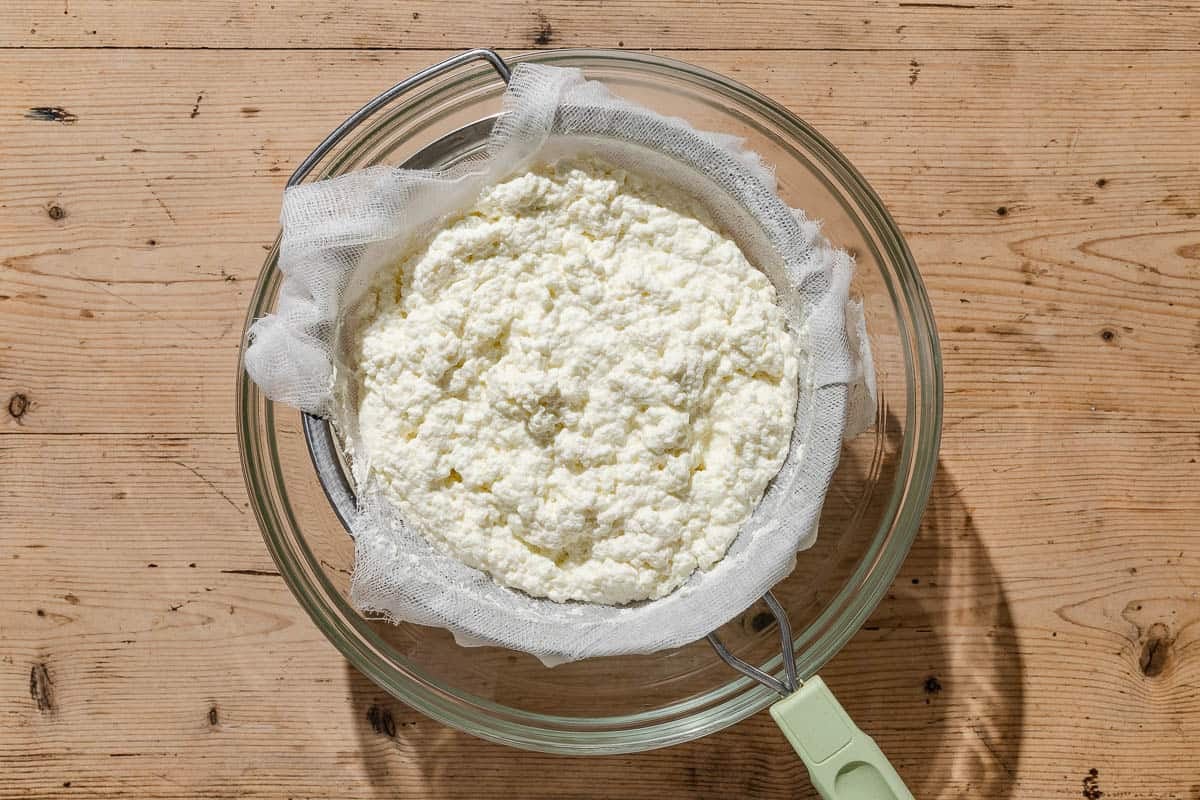
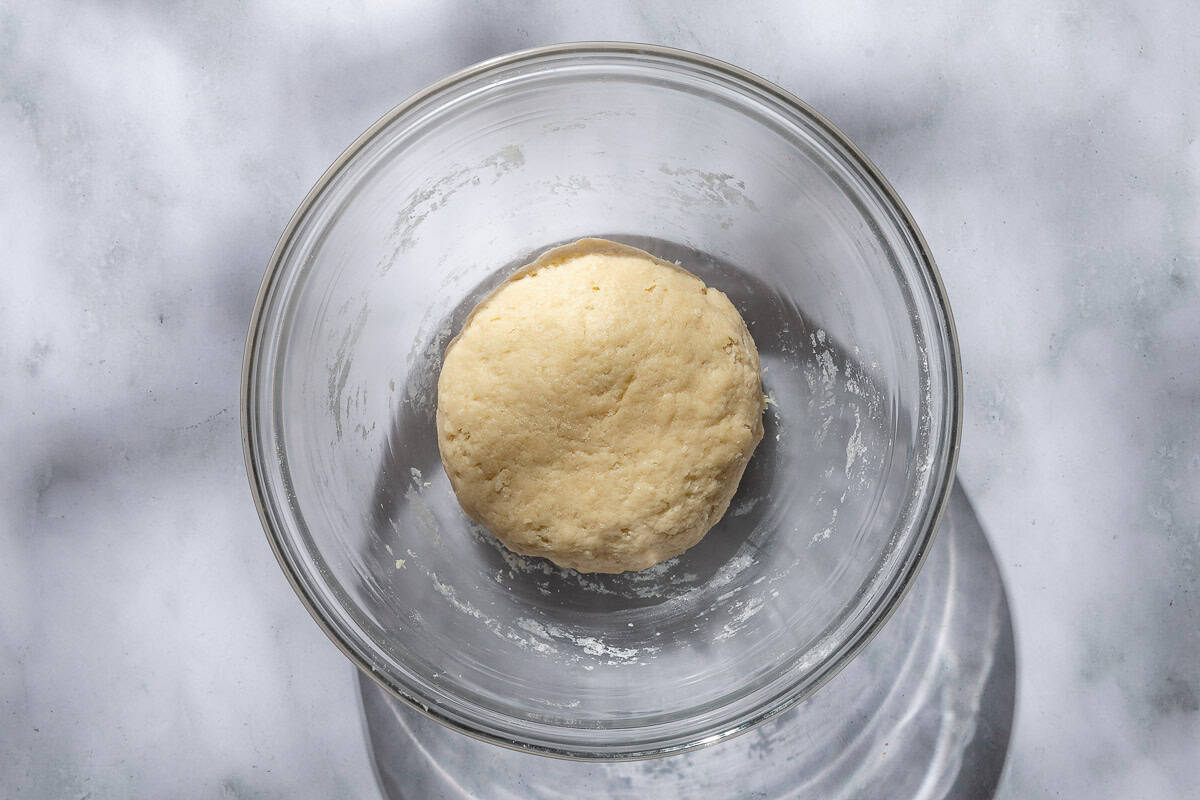
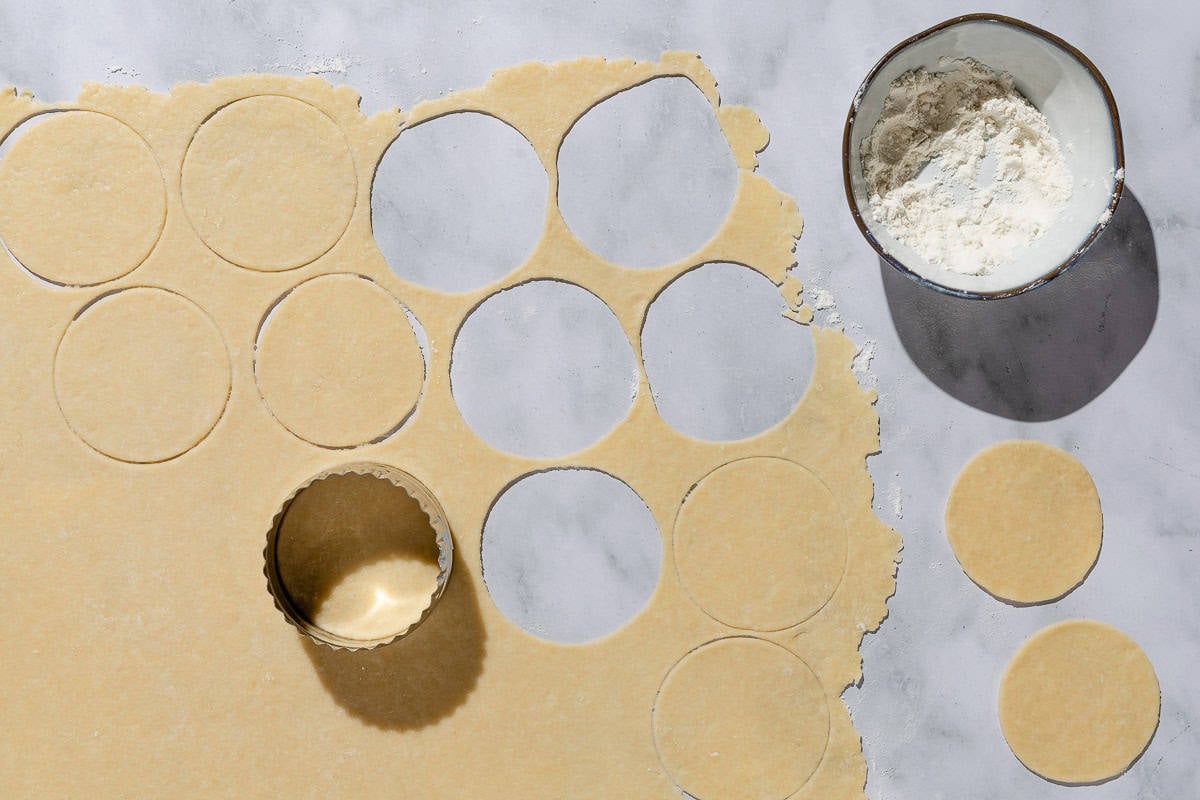
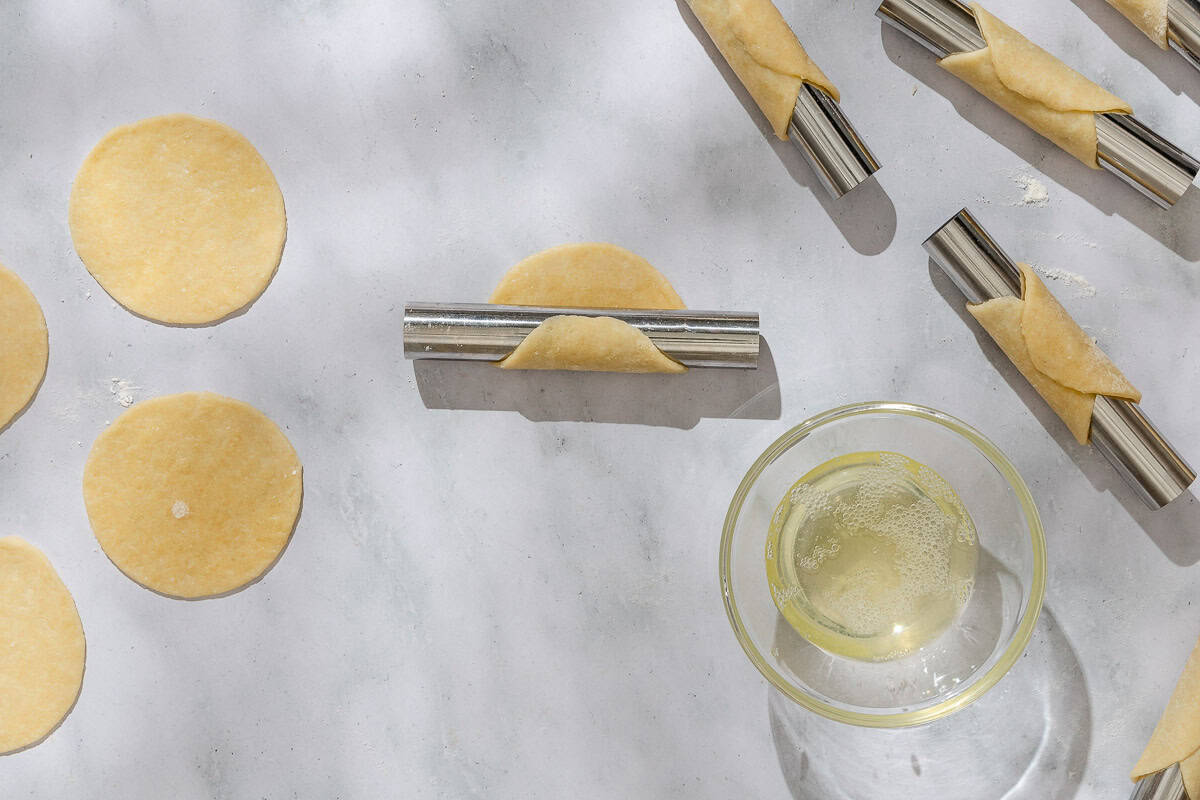
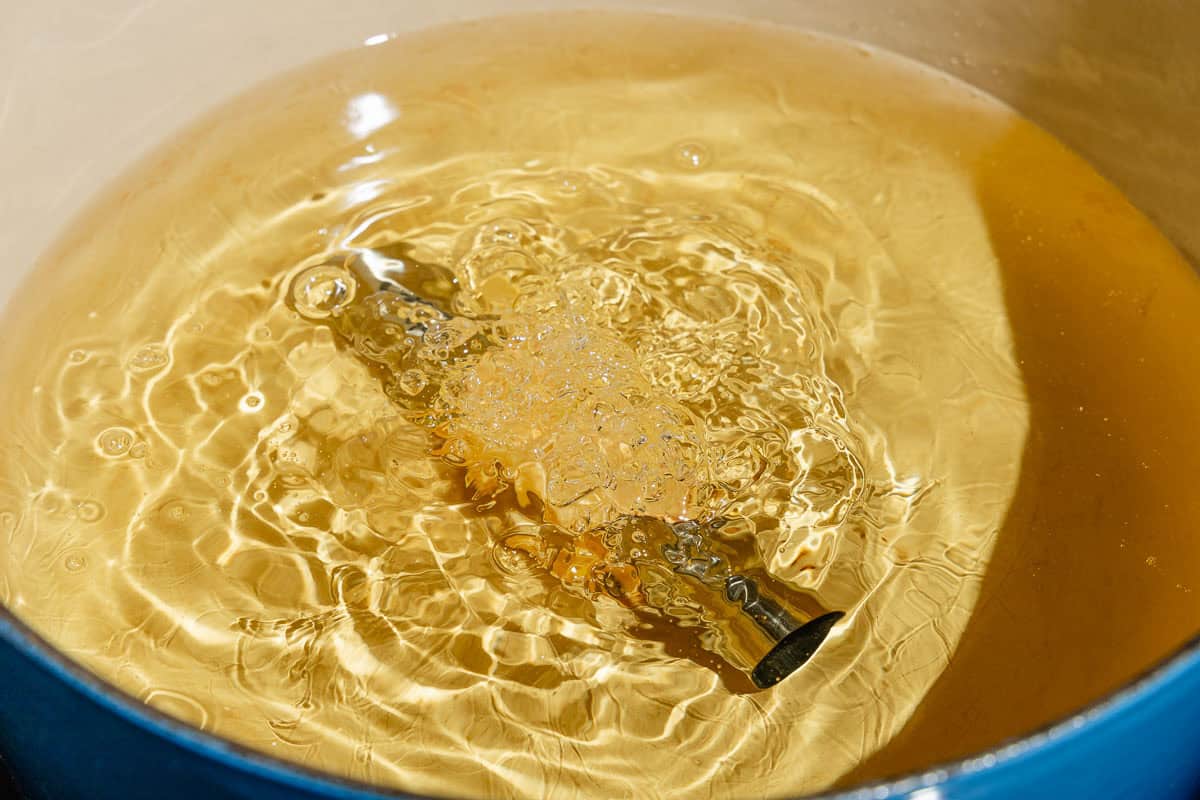
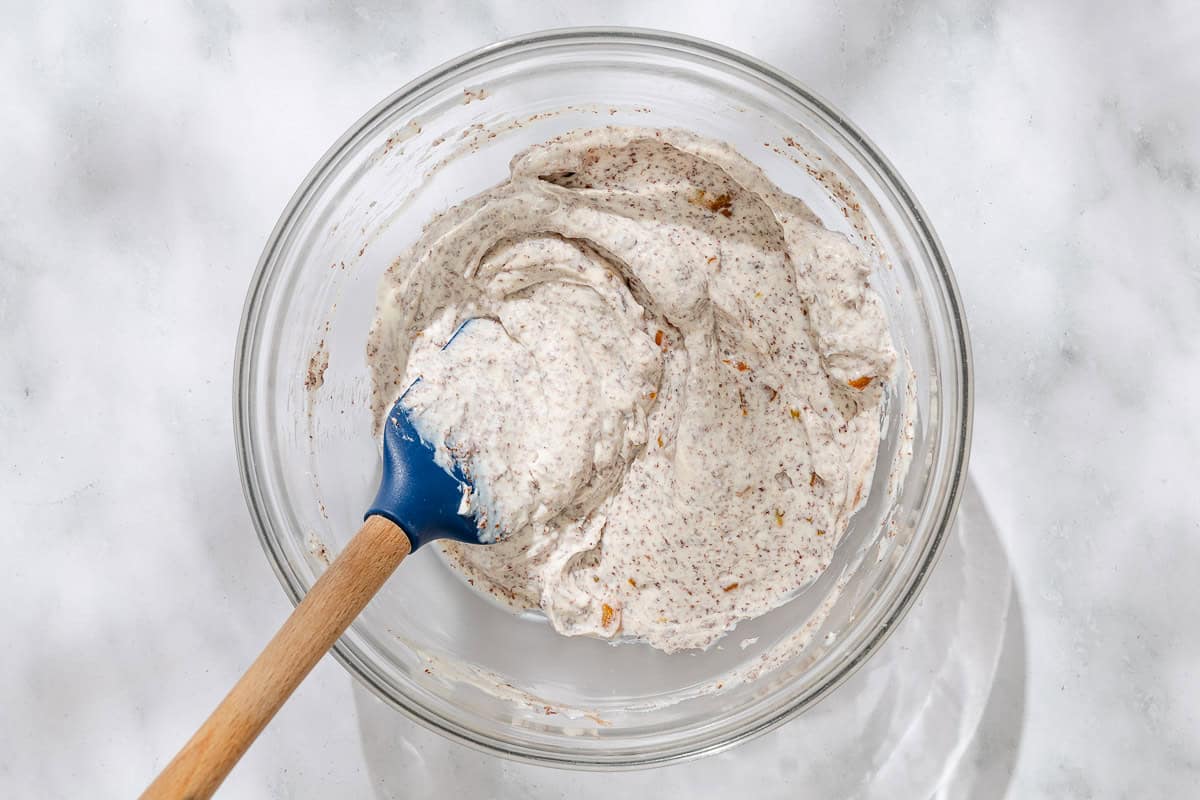
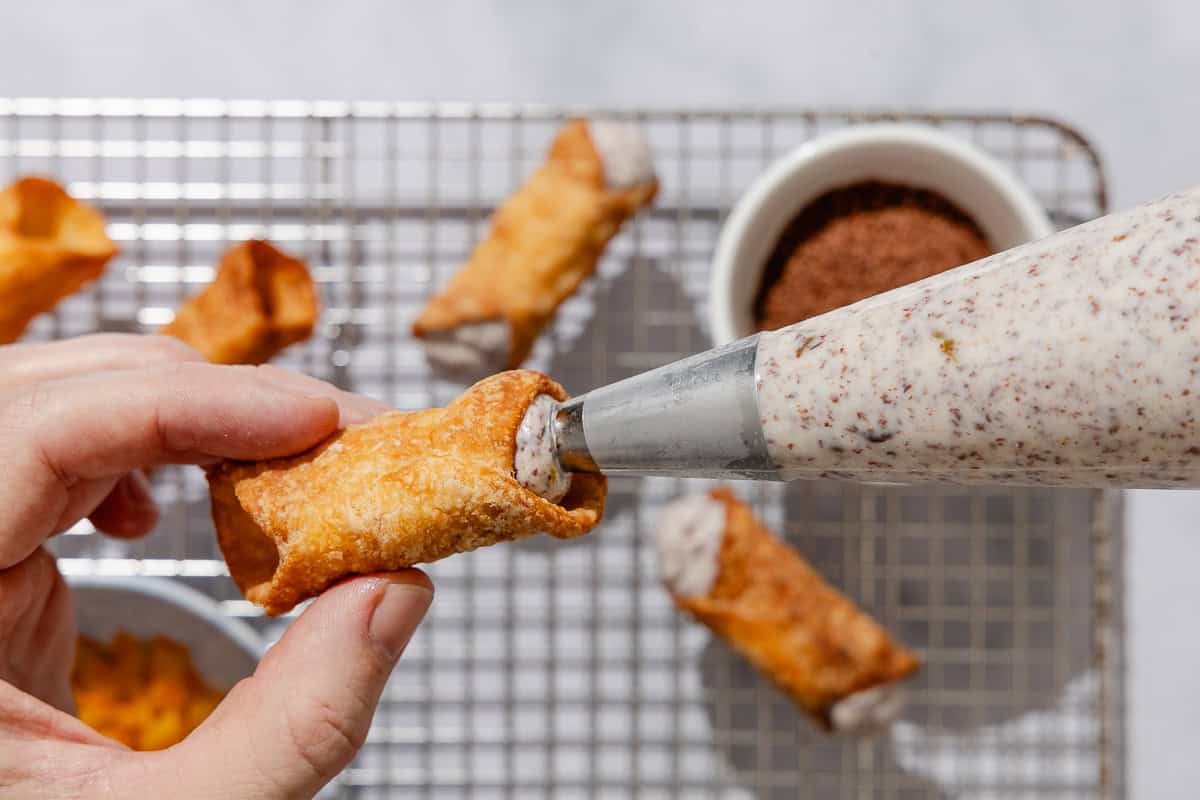
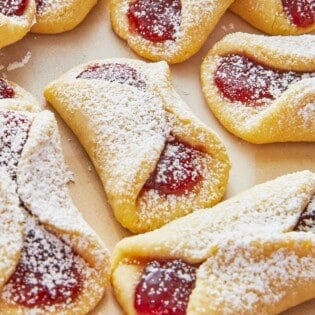
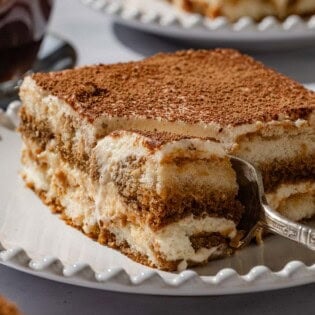
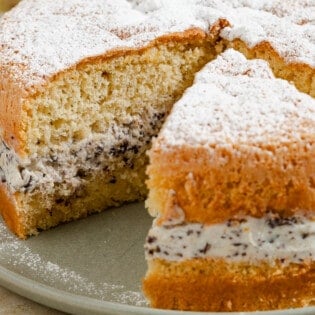

I’ve never made cannolis, but would like to learn.
You have come to the right place! Hope you give the recipe a try!